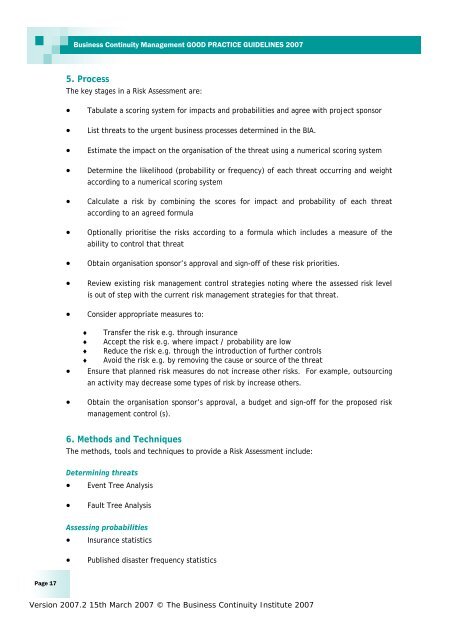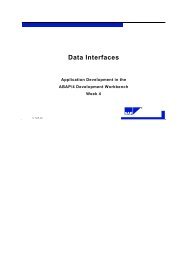business continuity institute good practice guidelines 2007
business continuity institute good practice guidelines 2007
business continuity institute good practice guidelines 2007
Create successful ePaper yourself
Turn your PDF publications into a flip-book with our unique Google optimized e-Paper software.
Page 17<br />
Business Continuity Management GOOD PRACTICE GUIDELINES <strong>2007</strong><br />
5. Process<br />
The key stages in a Risk Assessment are:<br />
• Tabulate a scoring system for impacts and probabilities and agree with project sponsor<br />
• List threats to the urgent <strong>business</strong> processes determined in the BIA.<br />
• Estimate the impact on the organisation of the threat using a numerical scoring system<br />
• Determine the likelihood (probability or frequency) of each threat occurring and weight<br />
according to a numerical scoring system<br />
• Calculate a risk by combining the scores for impact and probability of each threat<br />
according to an agreed formula<br />
• Optionally prioritise the risks according to a formula which includes a measure of the<br />
ability to control that threat<br />
• Obtain organisation sponsor’s approval and sign-off of these risk priorities.<br />
• Review existing risk management control strategies noting where the assessed risk level<br />
is out of step with the current risk management strategies for that threat.<br />
• Consider appropriate measures to:<br />
♦ Transfer the risk e.g. through insurance<br />
♦ Accept the risk e.g. where impact / probability are low<br />
♦ Reduce the risk e.g. through the introduction of further controls<br />
♦ Avoid the risk e.g. by removing the cause or source of the threat<br />
• Ensure that planned risk measures do not increase other risks. For example, outsourcing<br />
an activity may decrease some types of risk by increase others.<br />
• Obtain the organisation sponsor’s approval, a budget and sign-off for the proposed risk<br />
management control (s).<br />
6. Methods and Techniques<br />
The methods, tools and techniques to provide a Risk Assessment include:<br />
Determining threats<br />
• Event Tree Analysis<br />
• Fault Tree Analysis<br />
Assessing probabilities<br />
• Insurance statistics<br />
• Published disaster frequency statistics<br />
Version <strong>2007</strong>.2 15th March <strong>2007</strong> © The Business Continuity Institute <strong>2007</strong>
















